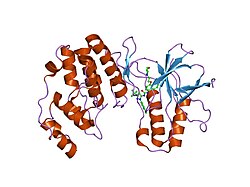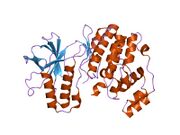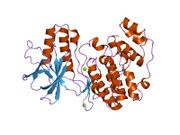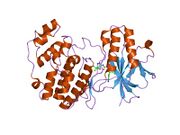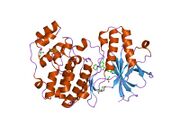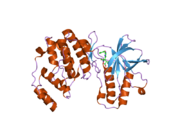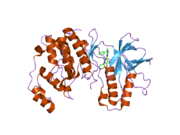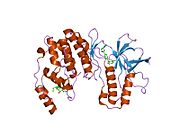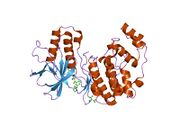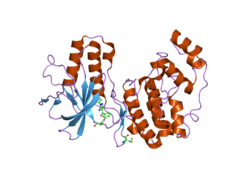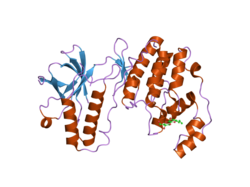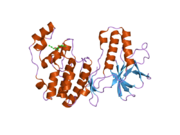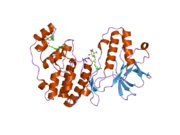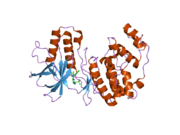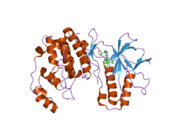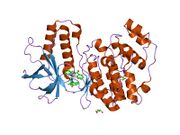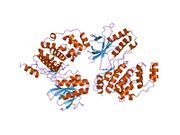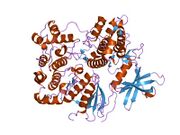Biology:MAPK14
 Generic protein structure example |
Mitogen-activated protein kinase 14, also called p38-α, is an enzyme that in humans is encoded by the MAPK14 gene.[1]
MAPK14 encodes p38α mitogen-activated protein kinase (MAPK) which is the prototypic member of the p38 MAPK family. p38 MAPKs are also known as stress-activated serine/threonine-specific kinases (SAPKs). In addition to MAPK14 for p38α MAPK, the p38 MAPK family has three additional members, including MAPK11, MAPK12 and MAPK13 which encodes p38β MAPK, p38γ MAPK and p38δ MAPK isoforms, respectively. p38α MAPK was originally identified as a tyrosine phosphorylated protein detected in activated immune cell macrophages with an essential role in inflammatory cytokine induction, such as Tumor Necrotic Factor α (TNFα).[2][3] However, p38α MAPK mediated kinase activity has been implicated in many tissues beyond immune systems. p38α MAPK is mainly activated through MAPK kinase kinase cascades and exerts its biological function via downstream substrate phosphorylation. p38α MAPK is implicated in diverse cellular functions, from gene expression to programmed cell death through a network of signaling molecules and transcription factors. Pharmacological and genetic inhibition of p38α MAPK not only revealed its biological significance in physiological function but also the potential of targeting p38α MAPK in human disease such as immune disorders and heart failure.
Structure
MAPK14 is a 41 kDa protein composed of 360 amino acids.[4][5]
Function
The protein encoded by this gene is a member of the MAP kinase family. MAP kinases act as an integration point for multiple biochemical signals, and are involved in a wide variety of cellular processes such as proliferation, differentiation, transcription regulation and development. This kinase is activated by various environmental stresses and proinflammatory cytokines. The activation requires its phosphorylation by MAP kinase kinases (MKKs), or its autophosphorylation triggered by the interaction of MAP3K7IP1/TAB1 protein with this kinase. The substrates of this kinase include transcription regulator ATF2, MEF2C, and MAX, cell cycle regulator CDC25B, and tumor suppressor p53, which suggest the roles of this kinase in stress-related transcription and cell cycle regulation, as well as in genotoxic stress response. Four alternatively spliced transcript variants of this gene encoding distinct isoforms have been reported.[6]
p38α MAPK is ubiquitously expressed in many cell types, in contrast, p38β MAPK is highly expressed in brain and lung, p38γ MAPK mostly in skeletal muscle and nerve system, and p38δ MAPK in uterus and pancreas.[7][8] Like all MAP kinases, p38α MAPK has 11 conserved domains (Domains I to XI) and a Thr-Gly-Tyr (TGY) dual phosphorylation motif. Activation of p38 MAPK pathway has been implicated in a variety of stress response in addition to inflammation, including osmotic shock, heat, and oxidative stress.[7][9][10] The canonical pathway for p38 MAPK activation involve a cascade of protein kinases, including MAP3K such as MEKK1, 2, 3 and 4, TGFβ-activated kinase (TAK1), TAO1-3, mixed-lineage kinase 2/3 (MLK2/3), and apoptosis signal-regulating kinase 1/2 (ASK1/2), as well as MAP2Ks, such as MKK3, 6 and 4. MAP2K mediated phosphorylation of the TGY motif results in conformational change of p38 MAPK which allows kinase activation and accessibility to substrates.[11] In addition, TAK1-binding protein 1 (TAB1) and ZAP70 can induce p38 MAPK via non-canonical autophosphorylation.[12][13][14] Furthermore, acetylation of p38 MAPK at lys-53 of the ATP-binding pocket also enhances p38 MAPK activity during cellular stress[15] Under basal conditions, p38α MAPK is detected in both the nucleus and the cytoplasm. One of the consequences of p38 MAPK activation is translocation into the nucleus.[16] involving both p38 MAPK phosphorylation and microtubule- and dynein-dependent process.[17] In addition, one substrate of p38 MAPK, MAP kinase-activated protein kinase 2 (MAPAK2 or MK2) can modulate and direct p38α MAPK localization to cytosole via direct interaction.[18] p38α MAPK activation can be reversed by dephosphorylation of the TGY motif carried out by protein phosphatases, including ser-thr protein phosphatases (PPs), protein tyrosine phosphatases (PTP), and dual-specificity phosphatases (DUSP). For example, ser/thr phosphatases PP2Cα/β suppress activity of p38s MAPK through direct interaction as well as suppression of MKKs/TAK1 in mammalian cells.[19][20] Hematopoietic PTP (HePTP) and striatal-enriched phosphatase (STEP) bind to MAPKs through a kinase-interaction motif (KIM) and inactivates them by dephosphorylating the phosphotyrosine residue in their activation loop.[21][22][23] DUSPs, which have a docking domain to MAPKs and dual-specific phosphatase activity, can also bind to p38 MAPKs and dephosphorylate of both phosphotyrosine and phosphothreonine residues.[11] In addition to these phosphatases, other molecular components such as Hsp90-Cdc37 chaperone complex can also modulate p38 MAPK autophosphorylation activity and prevents non-canonical activation.[24]
p38α MAPK is implicated in cell survival/apoptosis, proliferation, differentiation, migration, mRNA stability, and inflammatory response in different cell types through variety of different target molecules[25] MK2 is one of the well-studied downstream targets of p38α MAPK. Their downstream substrates include small heat shock protein 27 (HSP27), lymphocyte-specific protein1 (LSP1), cAMP response element-binding protein (CREB), cyclooxygenase 2 (COX2), activating transcription factor 1 (ATF1), serum response factor (SRF), and mRNA-binding protein tristetraprolin (TTP)[16][26] In addition to protein kinases, many transcription factors are downstream targets of p38α MAPK, including ATF1/2/6, c-Myc, c-FOS, GATA4, MEF2A/C, SRF, STAT1, and CHOP[27][28][29][30]
Role in cardiovascular system
p38α MAPK constitutes the main p38 MAPK activity in heart. During cardiomyocyte maturation in new born mouse heart, p38α MAPK activity can regulate myocyte cytokinesis and promote cell cycle exit.[31] while inhibition of p38 MAPK activity leads to induction of mitosis in both adult and fetal cardiomyocyte.[32][33] Therefore, p38 MAPK is associated with cell-cycle arrest in mammalian cardiomyocytes and its inhibition may represent a strategy to promote cardiac regeneration in response to injury. In addition, p38α MAPK induction promotes myocyte apoptosis.[34][35] via downstream targets STAT1, CHOP, FAK, SMAD, cytochrome c, NF-κB, PTEN, and p53.[36][37][38][39][40][41][42] p38 MAPK can also target IRS-1 mediated AKT signaling and promotes myocyte death under chronic insulin stimulation.[43] Inhibition of p38 MAPK activity confers cardioprotection against ischemia reperfusion injury in heart[44][45] However, some reports demonstrated that p38 MAPK also involves in anti-apoptotic effect via phosphorylation of αβ-Crystallin or induction of Pim-3 during early response to oxidative stress or anoxic preconditioning respectively[46][47][48] Both p38α MAPK and p38β MAPK appear to have an opposite role in apoptosis.[49] Whereas p38α MAPK has a pro-apoptotic role via p53 activation, p38β MAPK has a pro-survival role via inhibition of ROS formation.[50][51] In general, chronic activation of p38 MAPK activity is viewed as pathological and pro-apoptotic, and inhibition of p38 MAPK activity is in clinical evaluation as a potential therapy to mitigate acute injury in ischemic heart failure.[52] p38 MAPK activity is also implicated in cardiac hypertrophy which is a significant feature of pathological remodeling in the diseased hearts and a major risk factor for heart failure and advert outcome. Most in vitro evidence supports that p38 MAPK activation promotes cardiomyocyte hypertrophy.[49][53][54][55] However, in vivo evidence suggest that chronic activation of p38 MAPK activity triggers restrictive cardiomyopathy with limited hypertrophy,[56] while genetic inactivation p38α MAPK in mouse heart results in an elevated cardiac hypertrophy in response to pressure overload[57][58] or swimming exercise.[59] Therefore, the functional role of p38 MAPK in cardiac hypertrophy remains controversial and yet to be further elucidated.
Interactions
MAPK14 has been shown to interact with:
Notes
The 2015 version of this article was updated by an external expert under a dual publication model. The corresponding academic peer reviewed article was published in Gene and can be cited as: "p38 MAP kinases in the heart". Gene 575 (2 Pt 2): 369–76. 10 January 2016. doi:10.1016/J.GENE.2015.09.030. PMID 26390817. PMC 4860190. https://dx.doi.org/10.1016/J.GENE.2015.09.030. |
References
- ↑ "A protein kinase involved in the regulation of inflammatory cytokine biosynthesis". Nature 372 (6508): 739–46. January 1995. doi:10.1038/372739a0. PMID 7997261.
- ↑ "A MAP kinase targeted by endotoxin and hyperosmolarity in mammalian cells". Science 265 (5173): 808–11. Aug 1994. doi:10.1126/science.7914033. PMID 7914033. Bibcode: 1994Sci...265..808H.
- ↑ "Endotoxin induces rapid protein tyrosine phosphorylation in 70Z/3 cells expressing CD14". The Journal of Biological Chemistry 268 (33): 25009–14. Nov 1993. doi:10.1016/S0021-9258(19)74564-5. PMID 7693711.
- ↑ ]"Integration of cardiac proteome biology and medicine by a specialized knowledgebase". Circulation Research 113 (9): 1043–53. Oct 2013. doi:10.1161/CIRCRESAHA.113.301151. PMID 23965338.
- ↑ "Mitogen-activated protein kinase 14". Cardiac Organellar Protein Atlas Knowledgebase (COPaKB). http://www.heartproteome.org/copa/ProteinInfo.aspx?QType=Protein%20ID&QValue=Q16539.
- ↑ "Entrez Gene: MAPK14 mitogen-activated protein kinase 14". https://www.ncbi.nlm.nih.gov/sites/entrez?Db=gene&Cmd=ShowDetailView&TermToSearch=1432.
- ↑ 7.0 7.1 "The p38 signal transduction pathway: activation and function". Cellular Signalling 12 (1): 1–13. Jan 2000. doi:10.1016/s0898-6568(99)00071-6. PMID 10676842.
- ↑ "Evolutionary history of the vertebrate mitogen activated protein kinases family". PLOS ONE 6 (10): e26999. 2011. doi:10.1371/journal.pone.0026999. PMID 22046431. Bibcode: 2011PLoSO...626999L.
- ↑ "Mitogen-activated protein kinase pathways mediated by ERK, JNK, and p38 protein kinases". Science 298 (5600): 1911–2. Dec 2002. doi:10.1126/science.1072682. PMID 12471242. Bibcode: 2002Sci...298.1911J.
- ↑ "Mammalian mitogen-activated protein kinase signal transduction pathways activated by stress and inflammation". Physiological Reviews 81 (2): 807–69. Apr 2001. doi:10.1152/physrev.2001.81.2.807. PMID 11274345.
- ↑ 11.0 11.1 "Mechanisms and functions of p38 MAPK signalling". The Biochemical Journal 429 (3): 403–17. Aug 2010. doi:10.1042/BJ20100323. PMID 20626350. https://zenodo.org/record/3427069.
- ↑ "Alternative p38 activation pathway mediated by T cell receptor-proximal tyrosine kinases". Nature Immunology 6 (4): 390–5. Apr 2005. doi:10.1038/ni1177. PMID 15735648.
- ↑ 13.0 13.1 "MAPKK-independent activation of p38alpha mediated by TAB1-dependent autophosphorylation of p38alpha". Science 295 (5558): 1291–4. Feb 2002. doi:10.1126/science.1067289. PMID 11847341. Bibcode: 2002Sci...295.1291G.
- ↑ "Diverse mechanisms of myocardial p38 mitogen-activated protein kinase activation: evidence for MKK-independent activation by a TAB1-associated mechanism contributing to injury during myocardial ischemia". Circulation Research 93 (3): 254–61. Aug 2003. doi:10.1161/01.RES.0000083490.43943.85. PMID 12829618.
- ↑ "Acetylation of a conserved lysine residue in the ATP binding pocket of p38 augments its kinase activity during hypertrophy of cardiomyocytes". Molecular and Cellular Biology 31 (11): 2349–63. Jun 2011. doi:10.1128/MCB.01205-10. PMID 21444723.
- ↑ 16.0 16.1 "Activation and signaling of the p38 MAP kinase pathway". Cell Research 15 (1): 11–8. Jan 2005. doi:10.1038/sj.cr.7290257. PMID 15686620.
- ↑ "Mechanisms regulating the nuclear translocation of p38 MAP kinase". Journal of Cellular Biochemistry 110 (6): 1420–9. Aug 2010. doi:10.1002/jcb.22675. PMID 20506250.
- ↑ "Nuclear export of the stress-activated protein kinase p38 mediated by its substrate MAPKAP kinase-2". Current Biology 8 (19): 1049–57. Sep 1998. doi:10.1016/s0960-9822(98)70442-7. PMID 9768359.
- ↑ "Selective suppression of stress-activated protein kinase pathway by protein phosphatase 2C in mammalian cells". FEBS Letters 437 (3): 172–6. Oct 1998. doi:10.1016/s0014-5793(98)01229-0. PMID 9824284.
- ↑ "Protein phosphatase 2Calpha inhibits the human stress-responsive p38 and JNK MAPK pathways". The EMBO Journal 17 (16): 4744–52. Aug 1998. doi:10.1093/emboj/17.16.4744. PMID 9707433.
- ↑ "PTP-SL and STEP protein tyrosine phosphatases regulate the activation of the extracellular signal-regulated kinases ERK1 and ERK2 by association through a kinase interaction motif". The EMBO Journal 17 (24): 7337–50. Dec 1998. doi:10.1093/emboj/17.24.7337. PMID 9857190.
- ↑ "Inhibition of T cell signaling by mitogen-activated protein kinase-targeted hematopoietic tyrosine phosphatase (HePTP)". The Journal of Biological Chemistry 274 (17): 11693–700. Apr 1999. doi:10.1074/jbc.274.17.11693. PMID 10206983.
- ↑ "Negative regulation of T cell antigen receptor signal transduction by hematopoietic tyrosine phosphatase (HePTP)". The Journal of Biological Chemistry 273 (25): 15340–4. Jun 1998. doi:10.1074/jbc.273.25.15340. PMID 9624114.
- ↑ "Specific regulation of noncanonical p38alpha activation by Hsp90-Cdc37 chaperone complex in cardiomyocyte". Circulation Research 106 (8): 1404–12. Apr 2010. doi:10.1161/CIRCRESAHA.109.213769. PMID 20299663.
- ↑ "Perspective on the discovery and scientific impact of p38 MAP kinase". Journal of Biomolecular Screening 18 (10): 1156–63. Dec 2013. doi:10.1177/1087057113497401. PMID 23896688.
- ↑ "Mitogen-activated protein kinase signaling in the heart: angels versus demons in a heart-breaking tale". Physiological Reviews 90 (4): 1507–46. Oct 2010. doi:10.1152/physrev.00054.2009. PMID 20959622.
- ↑ "Pro-inflammatory cytokines and environmental stress cause p38 mitogen-activated protein kinase activation by dual phosphorylation on tyrosine and threonine". The Journal of Biological Chemistry 270 (13): 7420–6. Mar 1995. doi:10.1074/jbc.270.13.7420. PMID 7535770.
- ↑ "The role of ATF-2 in oncogenesis". BioEssays 30 (4): 314–27. Apr 2008. doi:10.1002/bies.20734. PMID 18348191.
- ↑ "Interaction between bound cupric ion and spin-labeled cysteine beta-93 in human and horse hemoglobins". Journal of Inorganic Biochemistry 25 (2): 95–108. Oct 1985. doi:10.1016/0162-0134(85)80018-0. PMID 2997391. https://zenodo.org/record/1258341.
- ↑ "Feedback regulation of p38 activity via ATF2 is essential for survival of embryonic liver cells". Genes & Development 21 (16): 2069–82. Aug 2007. doi:10.1101/gad.430207. PMID 17699753.
- ↑ "Anillin localization defect in cardiomyocyte binucleation". Journal of Molecular and Cellular Cardiology 41 (4): 601–12. Oct 2006. doi:10.1016/j.yjmcc.2006.06.012. PMID 16889791.
- ↑ "FGF1/p38 MAP kinase inhibitor therapy induces cardiomyocyte mitosis, reduces scarring, and rescues function after myocardial infarction". Proceedings of the National Academy of Sciences of the United States of America 103 (42): 15546–51. Oct 2006. doi:10.1073/pnas.0607382103. PMID 17032753. Bibcode: 2006PNAS..10315546E.
- ↑ "p38 MAP kinase inhibition enables proliferation of adult mammalian cardiomyocytes". Genes & Development 19 (10): 1175–87. May 2005. doi:10.1101/gad.1306705. PMID 15870258.
- ↑ "Targeted inhibition of p38 mitogen-activated protein kinase antagonizes cardiac injury and cell death following ischemia-reperfusion in vivo". The Journal of Biological Chemistry 279 (15): 15524–30. Apr 2004. doi:10.1074/jbc.M313717200. PMID 14749328.
- ↑ "Hypoxia, angiotensin-II, and norepinephrine mediated apoptosis is stimulus specific in canine failed cardiomyocytes: a role for p38 MAPK, Fas-L and cyclin D1". European Journal of Heart Failure 5 (2): 121–9. Mar 2003. doi:10.1016/s1388-9842(02)00254-4. PMID 12644001.
- ↑ "Doxazosin induces activation of GADD153 and cleavage of focal adhesion kinase in cardiomyocytes en route to apoptosis". Cardiovascular Research 71 (1): 118–28. Jul 2006. doi:10.1016/j.cardiores.2006.03.014. PMID 16631627.
- ↑ "Hyperglycemia activates p53 and p53-regulated genes leading to myocyte cell death". Diabetes 50 (10): 2363–75. Oct 2001. doi:10.2337/diabetes.50.10.2363. PMID 11574421.
- ↑ "Taurine prevents arsenic-induced cardiac oxidative stress and apoptotic damage: role of NF-kappa B, p38 and JNK MAPK pathway". Toxicology and Applied Pharmacology 240 (1): 73–87. Oct 2009. doi:10.1016/j.taap.2009.07.008. PMID 19616567.
- ↑ "Regulation of phosphatase and tensin homolog on chromosome 10 in response to hypoxia". American Journal of Physiology. Heart and Circulatory Physiology 302 (9): H1806–17. May 2012. doi:10.1152/ajpheart.00929.2011. PMID 22367504.
- ↑ "Angiotensin II stimulates apoptosis via TGF-beta1 signaling in ventricular cardiomyocytes of rat". Journal of Molecular Medicine 84 (11): 975–83. Nov 2006. doi:10.1007/s00109-006-0090-0. PMID 16924465.
- ↑ "Induction of apoptosis and Fas receptor/Fas ligand expression by ischemia/reperfusion in cardiac myocytes requires serine 727 of the STAT-1 transcription factor but not tyrosine 701". The Journal of Biological Chemistry 276 (30): 28340–7. Jul 2001. doi:10.1074/jbc.M101177200. PMID 11309387.
- ↑ "PAF exerts a direct apoptotic effect on the rat H9c2 cardiomyocytes in Ca2+-dependent manner". International Journal of Cardiology 143 (1): 86–93. Aug 2010. doi:10.1016/j.ijcard.2009.01.068. PMID 19237210.
- ↑ "Myocardial loss of IRS1 and IRS2 causes heart failure and is controlled by p38α MAPK during insulin resistance". Diabetes 62 (11): 3887–900. Nov 2013. doi:10.2337/db13-0095. PMID 24159000.
- ↑ "Inhibition of p38 mitogen-activated protein kinase decreases cardiomyocyte apoptosis and improves cardiac function after myocardial ischemia and reperfusion". Circulation 99 (13): 1685–91. Apr 1999. doi:10.1161/01.cir.99.13.1685. PMID 10190877.
- ↑ "Role of p38alpha MAPK in cardiac apoptosis and remodeling after myocardial infarction". Journal of Molecular and Cellular Cardiology 38 (4): 617–23. Apr 2005. doi:10.1016/j.yjmcc.2005.01.012. PMID 15808838.
- ↑ "Oxidative stress and calpain inhibition induce alpha B-crystallin phosphorylation via p38 MAPK and calcium signalling pathways in H9c2 cells". Cellular Signalling 20 (7): 1292–302. Jul 2008. doi:10.1016/j.cellsig.2008.02.019. PMID 18420382.
- ↑ "Pim-3 protects against cardiomyocyte apoptosis in anoxia/reoxygenation injury via p38-mediated signal pathway". The International Journal of Biochemistry & Cell Biology 41 (11): 2315–22. Nov 2009. doi:10.1016/j.biocel.2009.05.021. PMID 19505587.
- ↑ "Cardioprotective role of P38 MAPK during myocardial infarction via parallel activation of α-crystallin B and Nrf2". Journal of Cellular Physiology 229 (9): 1272–82. Sep 2014. doi:10.1002/jcp.24565. PMID 24464634.
- ↑ 49.0 49.1 "Cardiac muscle cell hypertrophy and apoptosis induced by distinct members of the p38 mitogen-activated protein kinase family". The Journal of Biological Chemistry 273 (4): 2161–8. Jan 1998. doi:10.1074/jbc.273.4.2161. PMID 9442057.
- ↑ "Estrogen prevents cardiomyocyte apoptosis through inhibition of reactive oxygen species and differential regulation of p38 kinase isoforms". The Journal of Biological Chemistry 281 (10): 6760–7. Mar 2006. doi:10.1074/jbc.M511024200. PMID 16407188.
- ↑ "Oestrogen prevents cardiomyocyte apoptosis by suppressing p38α-mediated activation of p53 and by down-regulating p53 inhibition on p38β". Cardiovascular Research 89 (1): 119–28. Jan 2011. doi:10.1093/cvr/cvq265. PMID 20724307.
- ↑ "The p38 mitogen-activated protein kinase pathway--a potential target for intervention in infarction, hypertrophy, and heart failure". Journal of Molecular and Cellular Cardiology 51 (4): 485–90. Oct 2011. doi:10.1016/j.yjmcc.2010.10.021. PMID 21062627.
- ↑ "Redefining the roles of p38 and JNK signaling in cardiac hypertrophy: dichotomy between cultured myocytes and animal models". Journal of Molecular and Cellular Cardiology 35 (12): 1385–94. Dec 2003. doi:10.1016/j.yjmcc.2003.10.001. PMID 14654364.
- ↑ "Opposing effects of Jun kinase and p38 mitogen-activated protein kinases on cardiomyocyte hypertrophy". Molecular and Cellular Biology 18 (6): 3518–26. Jun 1998. doi:10.1128/mcb.18.6.3518. PMID 9584192.
- ↑ "A role for the p38 mitogen-activated protein kinase pathway in myocardial cell growth, sarcomeric organization, and cardiac-specific gene expression". The Journal of Cell Biology 139 (1): 115–27. Oct 1997. doi:10.1083/jcb.139.1.115. PMID 9314533.
- ↑ "The in vivo role of p38 MAP kinases in cardiac remodeling and restrictive cardiomyopathy". Proceedings of the National Academy of Sciences of the United States of America 98 (21): 12283–8. Oct 2001. doi:10.1073/pnas.211086598. PMID 11593045. Bibcode: 2001PNAS...9812283L.
- ↑ "p38alpha mitogen-activated protein kinase plays a critical role in cardiomyocyte survival but not in cardiac hypertrophic growth in response to pressure overload". Molecular and Cellular Biology 24 (24): 10611–20. Dec 2004. doi:10.1128/MCB.24.24.10611-10620.2004. PMID 15572667.
- ↑ "The role of the Grb2-p38 MAPK signaling pathway in cardiac hypertrophy and fibrosis". The Journal of Clinical Investigation 111 (6): 833–41. Mar 2003. doi:10.1172/JCI16290. PMID 12639989.
- ↑ "Apoptosis signal-regulating kinase 1/p38 signaling pathway negatively regulates physiological hypertrophy". Circulation 117 (4): 545–52. Jan 2008. doi:10.1161/CIRCULATIONAHA.107.710434. PMID 18195174.
- ↑ 60.0 60.1 "p38 Kinase-dependent MAPKAPK-2 activation functions as 3-phosphoinositide-dependent kinase-2 for Akt in human neutrophils". The Journal of Biological Chemistry 276 (5): 3517–23. Feb 2001. doi:10.1074/jbc.M005953200. PMID 11042204.
- ↑ "Pro-inflammatory cytokines and environmental stress cause p38 mitogen-activated protein kinase activation by dual phosphorylation on tyrosine and threonine". The Journal of Biological Chemistry 270 (13): 7420–6. Mar 1995. doi:10.1074/jbc.270.13.7420. PMID 7535770.
- ↑ 62.0 62.1 "Regulation of stress-responsive mitogen-activated protein (MAP) kinase pathways by TAO2". The Journal of Biological Chemistry 276 (19): 16070–5. May 2001. doi:10.1074/jbc.M100681200. PMID 11279118.
- ↑ "Mitogen-activated protein kinase kinase 7 is an activator of the c-Jun NH2-terminal kinase". Proceedings of the National Academy of Sciences of the United States of America 94 (14): 7337–42. Jul 1997. doi:10.1073/pnas.94.14.7337. PMID 9207092. Bibcode: 1997PNAS...94.7337T.
- ↑ 64.0 64.1 "Initiation of a G2/M checkpoint after ultraviolet radiation requires p38 kinase". Nature 411 (6833): 102–7. May 2001. doi:10.1038/35075107. PMID 11333986. Bibcode: 2001Natur.411..102B.
- ↑ "Stress-induced activation of protein kinase CK2 by direct interaction with p38 mitogen-activated protein kinase". The Journal of Biological Chemistry 275 (22): 16569–73. Jun 2000. doi:10.1074/jbc.M000312200. PMID 10747897.
- ↑ 66.0 66.1 66.2 "A Novel MAPK phosphatase MKP-7 acts preferentially on JNK/SAPK and p38 alpha and beta MAPKs". The Journal of Biological Chemistry 276 (28): 26629–39. Jul 2001. doi:10.1074/jbc.M101981200. PMID 11359773.
- ↑ 67.0 67.1 67.2 "Identification of a docking groove on ERK and p38 MAP kinases that regulates the specificity of docking interactions". The EMBO Journal 20 (3): 466–79. Feb 2001. doi:10.1093/emboj/20.3.466. PMID 11157753.
- ↑ "Molecular cloning and characterization of a novel dual specificity phosphatase, MKP-5". The Journal of Biological Chemistry 274 (28): 19949–56. Jul 1999. doi:10.1074/jbc.274.28.19949. PMID 10391943.
- ↑ "MKP-7, a novel mitogen-activated protein kinase phosphatase, functions as a shuttle protein". The Journal of Biological Chemistry 276 (42): 39002–11. Oct 2001. doi:10.1074/jbc.M104600200. PMID 11489891.
- ↑ "Distinct binding determinants for ERK2/p38alpha and JNK map kinases mediate catalytic activation and substrate selectivity of map kinase phosphatase-1". The Journal of Biological Chemistry 276 (19): 16491–500. May 2001. doi:10.1074/jbc.M010966200. PMID 11278799.
- ↑ "Downregulation of FUSE-binding protein and c-myc by tRNA synthetase cofactor p38 is required for lung cell differentiation". Nature Genetics 34 (3): 330–6. Jul 2003. doi:10.1038/ng1182. PMID 12819782.
- ↑ "Characterization of a novel human serine protease that has extensive homology to bacterial heat shock endoprotease HtrA and is regulated by kidney ischemia". The Journal of Biological Chemistry 275 (4): 2581–8. Jan 2000. doi:10.1074/jbc.275.4.2581. PMID 10644717.
- ↑ "Keratin 8 phosphorylation by p38 kinase regulates cellular keratin filament reorganization: modulation by a keratin 1-like disease causing mutation". The Journal of Biological Chemistry 277 (13): 10775–82. Mar 2002. doi:10.1074/jbc.M107623200. PMID 11788583.
- ↑ 74.0 74.1 "p38alpha isoform Mxi2 binds to extracellular signal-regulated kinase 1 and 2 mitogen-activated protein kinase and regulates its nuclear activity by sustaining its phosphorylation levels". Molecular and Cellular Biology 23 (9): 3079–90. May 2003. doi:10.1128/mcb.23.9.3079-3090.2003. PMID 12697810.
- ↑ "MKK3- and MKK6-regulated gene expression is mediated by the p38 mitogen-activated protein kinase signal transduction pathway". Molecular and Cellular Biology 16 (3): 1247–55. Mar 1996. doi:10.1128/mcb.16.3.1247. PMID 8622669.
- ↑ "Cloning and characterization of MEK6, a novel member of the mitogen-activated protein kinase kinase cascade". The Journal of Biological Chemistry 271 (19): 11427–33. May 1996. doi:10.1074/jbc.271.19.11427. PMID 8626699.
- ↑ "Cell type-specific inhibition of the ETS transcription factor ER81 by mitogen-activated protein kinase-activated protein kinase 2". The Journal of Biological Chemistry 276 (45): 41856–61. Nov 2001. doi:10.1074/jbc.M106630200. PMID 11551945.
- ↑ "Regulation of the MEF2 family of transcription factors by p38". Molecular and Cellular Biology 19 (1): 21–30. Jan 1999. doi:10.1128/mcb.19.1.21. PMID 9858528.
- ↑ "Targeting of p38 mitogen-activated protein kinases to MEF2 transcription factors". Molecular and Cellular Biology 19 (6): 4028–38. Jun 1999. doi:10.1128/mcb.19.6.4028. PMID 10330143.
- ↑ "RSK-B, a novel ribosomal S6 kinase family member, is a CREB kinase under dominant control of p38alpha mitogen-activated protein kinase (p38alphaMAPK)". The Journal of Biological Chemistry 273 (45): 29661–71. Nov 1998. doi:10.1074/jbc.273.45.29661. PMID 9792677.
- ↑ "Towards a proteome-scale map of the human protein-protein interaction network". Nature 437 (7062): 1173–8. Oct 2005. doi:10.1038/nature04209. PMID 16189514. Bibcode: 2005Natur.437.1173R.
Further reading
- "Nuclear export of the stress-activated protein kinase p38 mediated by its substrate MAPKAP kinase-2". Current Biology 8 (19): 1049–57. Sep 1998. doi:10.1016/S0960-9822(98)70442-7. PMID 9768359.
- "p38 MAPK in development and cancer". Cell Cycle 5 (8): 824–8. Apr 2006. doi:10.4161/cc.5.8.2685. PMID 16627995.
- P. Sankaranarayanan; T. E. Schomay; K. A. Aiello; O. Alter (April 2015). "Tensor GSVD of Patient- and Platform-Matched Tumor and Normal DNA Copy-Number Profiles Uncovers Chromosome Arm-Wide Patterns of Tumor-Exclusive Platform-Consistent Alterations Encoding for Cell Transformation and Predicting Ovarian Cancer Survival". PLOS ONE 10 (4): e0121396. doi:10.1371/journal.pone.0121396. AAAS EurekAlert! Press Release and NAE Podcast Feature. PMID 25875127. Bibcode: 2015PLoSO..1021396S.
External links
- MAP Kinase Resource .
- Overview of all the structural information available in the PDB for UniProt: Q16539 (Mitogen-activated protein kinase 14) at the PDBe-KB.
 |



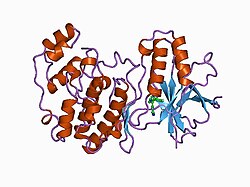
![1di9: The structure of p38 mitogen-activated protein kinase in complex with 4-[3-methylsulfanylanilino]-6,7-dimethoxyquinazoline](/wiki/images/thumb/1/18/PDB_1di9_EBI.jpg/250px-PDB_1di9_EBI.jpg)


